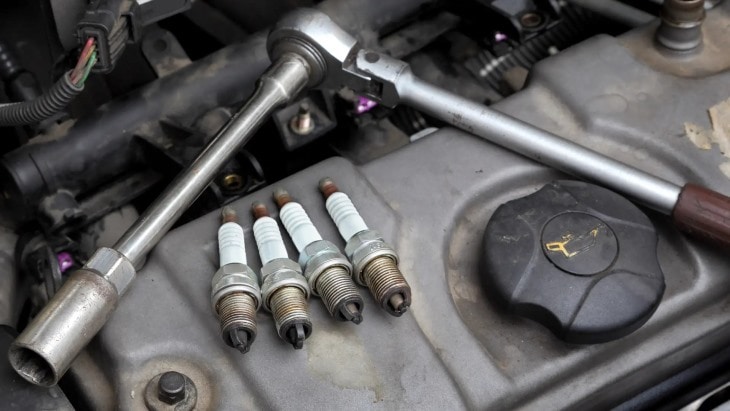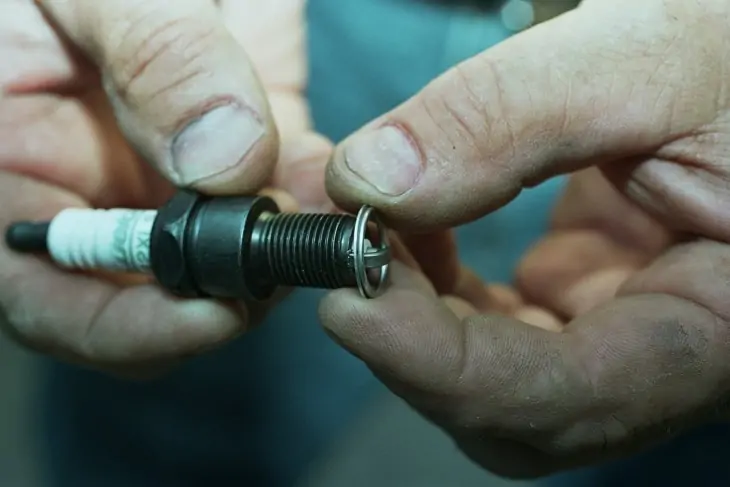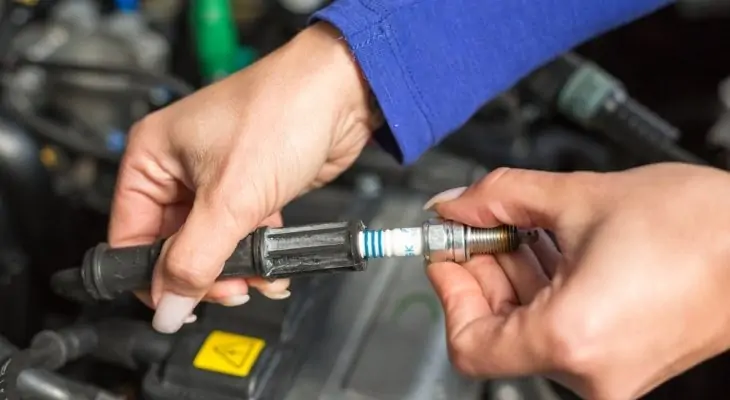Spark Plugs often break off when being removed. There is a straightforward method you can use to remove it safely without causing further damage.
Table of Contents
- What You Will Need
- Removing the Broken Spark Plug
- What Happens if the Easy-Out Extractor Breaks?
- How Often Should You Replace Your Spark Plugs?
- How Much Does it Cost to Replace Spark Plugs?
- Should You Replace All the Spark Plugs at the Same Time?
- Do You Need to Replace All the Spark Plugs If the Ignition Coil Fails?
What You Will Need

Did your spark plug snap off, leaving you holding the terminal while the nut half and the threaded portion with an electrode tip still installed in the cylinder head?
Now you have nothing to grab onto.
Stay calm, this is a common occurrence, and if you follow these simple instructions, you will have that spark plug replaced in no time. All you will need is:
- Hand drill
- Penetrating oil/Pb blaster
- Ratchet
- Anti-seize
- Air compressor
- Screwdriver
- Easy out extractor
- Pliers
- Flashlight
Once you have all these items, you can get started.
Removing the Broken Spark Plug
Use your Flashlight
Take your flashlight and illuminate the broken spark plug. You should see the hollowed-out threaded portion of the plug in the cylinder head.
Next, you will need to install an easy-out extractor. Should there not be enough space for one, you can use a smaller sized drill bit to make a tiny hole.
Installing the Easy Out Extractor
Pour the penetrating oil into the hollowed-out portion of the spark plug and let it soak for a few minutes. Use a spiral or square cut easy-out extractor and a bi-hex 12 point socket to steer the square or spiral end of the easy-out.
Insert the easy-out into the spark plug hole, ensuring you do so with a straight shot. Once inserted, tap the extractor with a hammer, gently pushing the extractor further into the hole.
Remove the Broken Portion of the Spark Plug
Take a wrench and attach it to the easy out. Slowly turn the wrench in a counter-clockwise direction. After a few turns, you will be able to feel the extractor grabbing the threads, turning them.
At this point, the broken spark plug should come out, and you can begin blowing out the crevice with an air compressor and insert a new spark plug.
Hopefully, it threads correctly.
What Happens If the Spark Plug Doesn’t Thread Correctly?
Threads can be destroyed while removing old spark plugs. You will need to re-thread the hole with a tap to accommodate the new spark plug.
Use an air compressor attachment to blow out the hole. Take some penetrating oil and pour it into the hole, giving it some time to soak.
Ensure you have the right tap for the threads on the spark plug.
One way of knowing which tap you need is by threading the spark plug into the correct die, as it will thread in perfectly. You can also purchase spark plug thread repair kits (like this one from CalVan Tools) that should have what you need if you do not own a tap and die set.
Reinstall the New Spark Plug

Using the air compressor one more time, blow out the spark plug hole. Thread the spark plug carefully into the new hole by hand.
Take a torque wrench with an extension and spark plug socket, tightening the spark plug in a clockwise motion. Ensure not to tighten it too much as it can strip the thread.
Reinstall the plug boot or ignition coil, and you are done!
What Happens if the Easy-Out Extractor Breaks?
Although extremely rare, easy-out extractors can break and get stuck in the hole but don’t panic. There is a way to remove it.
Using a solid carbide burr bit on a rotary tool like this one from Bosch, you can grind it out. Alternatively, you can use a skinny drill bit to drill holes around the extractor which will loosen it.
A riskier method would be to use a heat gun to soften the metal. You should use it with extreme caution as not to melt the cylinder head off.
How Often Should You Replace Your Spark Plugs?
Your spark plug’s operational life will depend on the type of spark plug you have installed. You get two types of spark plugs, long-life and conventional.
Conventional spark plugs need to be replaced every 30,000 to 50,000 miles. Long-life or platinum-tipped spark plugs need to be changed every 60,000 – 150,000 miles but might need to be changed before then.
How Much Does it Cost to Replace Spark Plugs?
Spark plugs themselves do not cost a lot. You can find conventional spark plugs for $6-$10 per plug. Long-life spark plugs can cost anywhere between $15-$40 each.
Labour will depend on the engine design and your location.
Generally, a repair shop can charge $60-$110 to replace spark plugs in a regular 4-cylinder engine.
Should You Replace All the Spark Plugs at the Same Time?

Yes, spark plugs need to be replaced as a set. Ensure you are using all the right parts as the wrong spark plugs may cause problems.
You should always inspect the new spark plugs before installing them.
If a new spark plug has been dropped, the insulator could crack. You will be able to see the cracks upon close inspection.
Do You Need to Replace All the Spark Plugs If the Ignition Coil Fails?
Should your ignition coil fail, it would be best to change all your spark plugs, especially if it’s been a while since they were replaced. If you have just installed new spark plugs, it will be acceptable only to change the spark plug in the affected cylinder.
Conclusion
If you know your way around tools and cars, changing a broken spark plug should be easy. Always use patience and caution when working with broken spark plugs. If you rush through the process, you can damage the thread and would need to re-thread the hole.
Re-threading is time-consuming and might lead you to have the spark plug replaced professionally, which will cost you more money in the end.
Always ensure you have your spark plugs replaced every 30,000 miles for conventional spark plugs and every 60,000 miles for long-life spark plugs.

